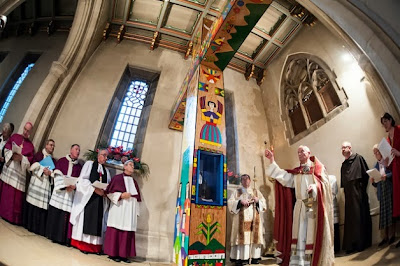A Victorian cathedral associated with English Catholics’ march
from repression to tolerance, bombed by Hitler during WWII and visited by John Paul
II in 1982, now houses an Oscar A. “Romero Space” that Salvadoran Ambassador Werner
Matías Romero (no relation) called “a
little piece of El Salvador” in the heart of London. Ambassadors and High Commissioners, members
of Parliament and other government officials joined clerics from the Catholic
and Anglican communities at St. George's Cathedral, including the Roman Catholic Archbishop of Southwark
(whose jurisdiction covers parts of London and points south) Peter Smith; the
Roman Catholic Bishop of Hallam (Province of Liverpool) John Rawsthorne; and
the Anglican Dean of Westminster, John Robert Hall, who heads the chapter at
Westminster Abbey, where a prominent statue of Oscar Romero has graced the
Royal Church’s western façade since 1998.
The assembly gathered for an ecumenical prayer service to inaugurate a
small chapel dedicated to Romero and to bless a large “Romero Cross,” in the
style pioneered by the Salvadoran muralist Fernando Llort, created by the
Salvadoran master in the highlands of El Salvador and shipped to London to
house an original clerical skullcap worn by Romero and a fragment of the
blood-stained alb Romero was wearing when he was killed.
Among the more than 1200 in attendance at the vigil on Thursday September 19, were
Llort; Romero’s younger brother, Gaspar Romero; and Romero’s vicar, Msgr.
Ricardo Urioste, who is the long serving president of the Romero Foundation in
El Salvador and who turned 88 earlier in the week. Msgr. Urioste was the featured speaker of the
evening, and he delivered brief but poignant remarks presenting Romero as a man
of God, a man of the Church, and a man of the people. His words were peppered with anecdotes about
Romero from a close associate. Recalling
Romero’s spirituality, Urioste recounted accompanying Romero on a trip to Rome
while he was Archbishop. “We went together to St. Peter's Basilica,”
Urioste recalled. “He knelt down before the altar and I knelt next to him. After a long
while, I stood up.” Urioste noticed
that Romero “was still in deep prayer and
I said to myself, ‘One must follow this man because he is following God’.” Explaining that Romero’s concept of the
Church included the laity, he recalled Romero approaching a homeless man after
a meeting with theologians. “I thought he was going to offer him some
help,” said Urioste. “Instead, he asked this man the same question
he had asked the theologians.”
Urioste quoted Romero’s journals from his last spiritual retreat, where
he writes about his fear of being assassinated, but ultimately accepts a
potentially violent death and prays for strength in facing it. Urioste calls these “some of the most beautiful words he ever wrote.”
Msgr. Urioste rejects the sudden conversion model of
Romero’s life, instead comparing the opening of Romero’s eyes to the Biblical
story of the Blind Man of Bethsaida (Mark 8:22-26), who is gradually given full
sight in a healing miracle performed by Jesus.
Romero “was always someone who
sought to do God´s will and God showed His will to him step by step,” said
Urioste. He closed with a heartfelt wish
for Romero’s sainthood:
In the course of history,
three bishops have been murdered in the temple. The first was the Bishop of
Krakow, Stanislaus. He was murdered for scolding the Polish king for his sins,
that is, for defending morality. The second was the Archbishop of Canterbury,
Thomas Becket, who was murdered for defending the Church´s rights and freedoms.
And the third was Archbishop Romero of San Salvador, who sought to be faithful
to the Gospel and to the teaching of the Church. He was murdered for defending
the poor.
The first two have been
canonized. Perhaps one day, God willing, Monseñor Oscar Romero will be
canonized, too.
In the symbolic highlight of the evening, the ecumenical assembly,
including canons wearing ermine trimmed mozzettas, lit Paschal candles and
circled the large, colorful cross in the vaulted chapel of the Romanesque
gothic cathedral. Dignitaries included Fr.
Michael Campbell-Johnston SJ, former British Provincial; Julian Filochowski, the head
of the Romero Trust; Canon John O’Toole, the Dean of the Cathedral; Jan
Graffius, the Curator from Stonyhurst College who restored Romero’s vestments
for preservation in San Salvador; Rev. Richard Carter, from St.
Martin-in-the-Fields in London, where Romero commemorations are held; Sister
Elizabeth Dawson, of the Sisters of the Sacred Hearts of Jesus and Mary; Clare Dixon,
CAFOD programme manager for Latin America; Fr. Tony Lester O.Carm, of the British
Province of Carmelite Friars; Sister Pamela Hussey SHCJ; Fr. Mark Hackeson; and
Chris Bain.
Archbishop Smith sprinkled holy water and swung an incense
censer as he circled the Cross during the blessing ceremony. As he did so, the words of Ambassador Matías
Romero seemed to frame the scene.
Referring to Archbishop Romero, the ambassador said, “He held us to a higher standard.” After the ceremony, members of the public
filed past the Cross, admiring it, snapping pictures. “Now on
his way to sainthood, the likeness of the Voice of the Voiceless stands today
in stone above the entrance to Westminster Abbey, and his image remains etched
in our minds, his example undimmed.”
Top: Msgr. Urioste delivers personal remarks. Bottom: artist Fernando Llort (center) lights a candle with Julian Filochowski (with his back to camera), while Gaspar Romero stands behind Llort, left, and Canon John O'Toole off to the right.















